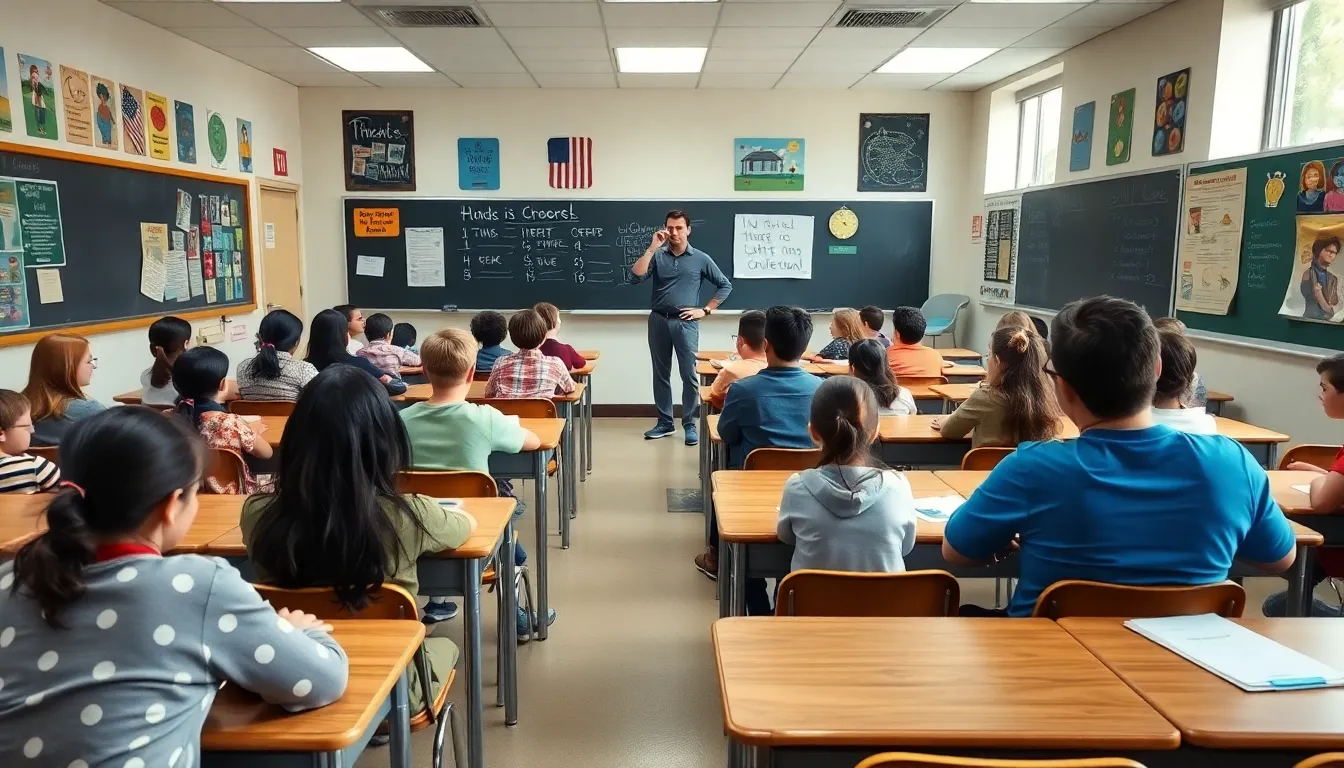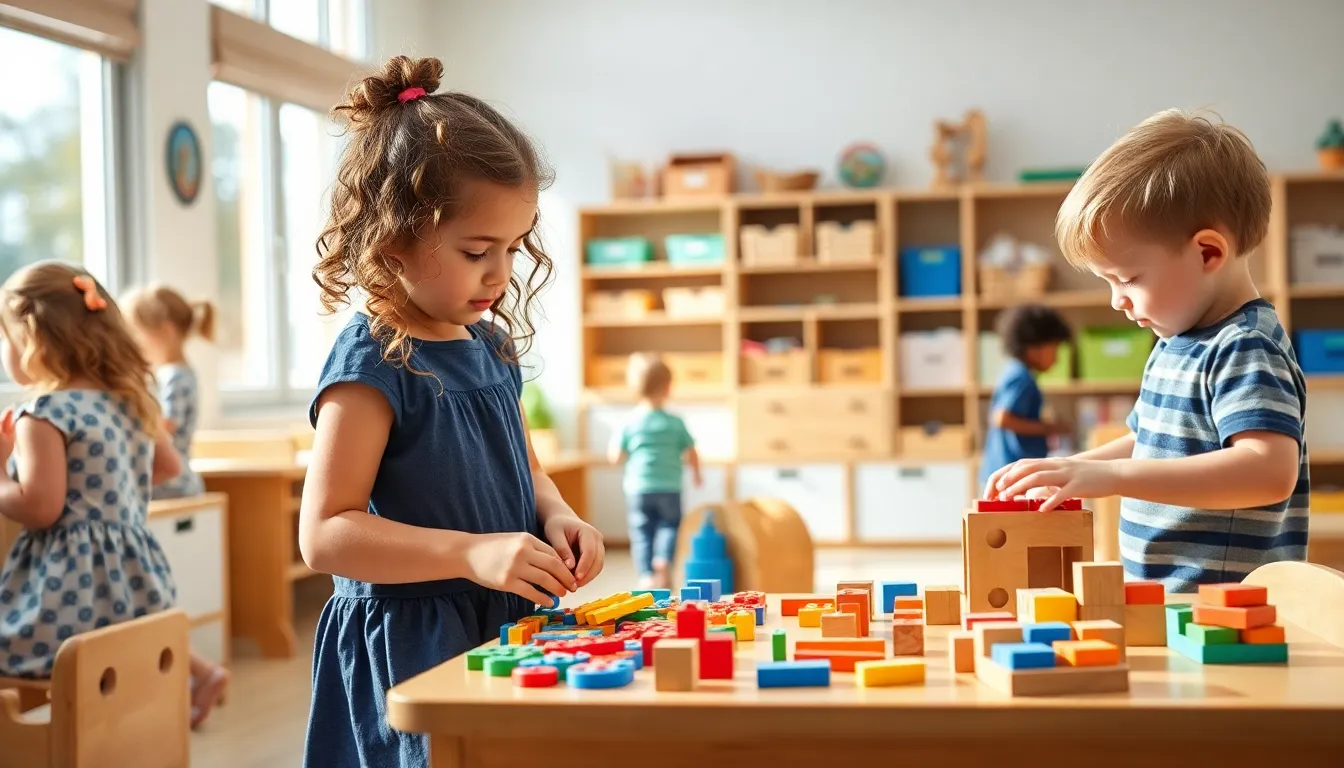When it comes to education, parents often find themselves at a crossroads. Should they choose the structured world of traditional education or dive into the hands-on, child-centered approach of Montessori? It’s a bit like deciding between a classic peanut butter and jelly sandwich or a gourmet avocado toast—both have their merits, but the choice can be a real head-scratcher.
Table of Contents
ToggleOverview of Montessori Education
Montessori education emphasizes a child-centered approach, nurturing independence and personal growth. This method focuses on creating an environment that fosters natural curiosity.
Core Principles of Montessori
Learning occurs at each child’s own pace. Montessori classrooms emphasize mixed-age groups, allowing peer learning. Children engage with hands-on materials, promoting exploration and problem-solving. Teachers act as guides, facilitating rather than dictating the learning process. Respect for each child’s development forms a fundamental part of the Montessori philosophy. Freedom within limits supports the development of decision-making skills.
Benefits of Montessori Approach
Children often show increased motivation due to the autonomy provided. Engagement in learning activities leads to deeper understanding of concepts. Montessori education enhances social skills through collaboration in diverse groups. Emotional intelligence develops, as children learn empathy and cooperation. Focus on fostering creativity prepares students for future challenges. Preparation for lifelong learning occurs through building critical thinking skills. Montessori graduates typically demonstrate strong self-discipline and confidence in their abilities.
Overview of Traditional Education

Traditional education follows a structured approach, relying on standardized curricula and teacher-led instruction. This method focuses on age-based grade levels and emphasizes academic achievement through formal assessments.
Key Characteristics of Traditional Education
Teacher-centered instruction defines traditional education. Classrooms typically feature rows of desks facing the front, where educators deliver content through lectures. Curriculum standards drive lesson plans, ensuring that objectives align with national or state guidelines. Assessment methods often involve standardized tests, measuring students’ knowledge retention. Regular homework assignments reinforce concepts learned during lessons. Class sizes tend to be larger, which can limit individual attention and personalized support.
Advantages of Traditional Methods
Structured environments provide stability for students in traditional education. Familiar routines help children understand expectations and develop discipline. Clear guidelines allow for measurable progress tracking. In many cases, immediate feedback from tests offers insights into academic performance. Social interactions among students foster a sense of community and belonging. Participation in activities such as sports or clubs enhances teamwork and leadership skills. Traditional education prepares students for higher education and job markets by instilling foundational knowledge and standardized skills.
Comparing Montessori and Traditional Education
When examining Montessori and traditional education, significant differences emerge in their fundamental approaches.
Learning Environment Differences
Montessori classrooms feature open spaces and accessible materials that encourage exploration. Students often choose their activities and learn at their own pace. In contrast, traditional classrooms emphasize structured environments with desks facing the teacher, promoting a more rigid framework. Standardized curricula dictate the learning process, limiting student autonomy. Mixed-age groups in Montessori promote peer learning, fostering collaboration. Traditional methods focus on age-specific groups that reinforce competition and comparison. Both environments influence student engagement, with Montessori’s settings often increasing motivation through choice and hands-on interactions.
Teacher’s Role in Both Approaches
In Montessori education, teachers act as guides facilitating learning rather than driving instruction. They observe students and encourage independent exploration. This contrasts sharply with traditional educators, who lead lessons and provide direct instruction to the class. Teachers in traditional settings often deliver standardized content and manage classroom behavior. Montessori teachers support individual decision-making, promoting skills like problem-solving and critical thinking. Traditional instructors focus on content delivery and adherence to the curriculum. These distinct roles impact students’ learning experiences and outcomes, influencing their development and preparation for future challenges.
Parent and Student Perspectives
Parents frequently express strong opinions about education models, particularly Montessori and traditional schooling. Many value Montessori’s focus on independence and hands-on learning, believing this approach nurtures their child’s unique interests. Others prefer traditional education, appreciating its structured nature and clear expectations. Decisions often hinge on the child’s learning style, with parents seeking environments that best support their individual needs. According to surveys, about 70% of Montessori parents report higher satisfaction compared to 50% of traditional education parents.
Students also react differently to each educational style. Montessori learners thrive in environments where they can explore at their own pace, often showing increased engagement and creativity. In contrast, students in traditional settings may excel in structured routines and enjoy clear guidance. Approximately 80% of students from Montessori settings report feeling more self-directed, while traditional education students often cite a sense of accomplishment from meeting specific benchmarks. These varying experiences underline the importance of aligning educational choices with personal preferences for both parents and students.
Choosing between Montessori and traditional education requires careful consideration of a child’s unique needs and learning style. Each approach offers valuable advantages that cater to different preferences. Montessori education fosters independence and creativity through hands-on learning and mixed-age collaboration. In contrast traditional education provides structure and clear guidelines that many students find comforting and effective.
Ultimately the best choice hinges on what aligns with a child’s personality and the values of their family. By understanding the fundamental differences between these educational philosophies parents can make informed decisions that support their child’s growth and development. Finding the right fit will not only enhance learning experiences but also cultivate a love for education that lasts a lifetime.




